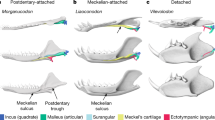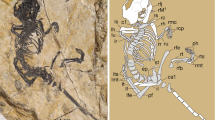Abstract
THE origin of human language, and in particular the question of whether or not Neanderthal man was capable of language/speech, is of major interest to anthropologists but remains an area of great controversy1, 2. Despite palaeoneurological evidence to the contrary3, 4, many researchers hold to the view that Neanderthals were incapable of language/speech, basing their arguments largely on studies of laryngeal/basicranial morphology1, 5, 6. Studies, however, have been hampered by the absence of unambiguous fossil evidence. We now report the discovery of a well-preserved human hyoid bone from Middle Palaeolithic layers of Kebara Cave, Mount Carmel, Israel, dating from about 60,000 years BP. The bone is almost identical in size and shape to the hyoid of present-day populations, suggesting that there has been little or no change in the visceral skeleton (including the hyoid, middle ear ossicles, and inferentially the larynx) during the past 60,000 years of human evolution. We conclude that the morphological basis for human speech capability appears to have been fully developed during the Middle Palaeolithic.
This is a preview of subscription content, access via your institution
Access options
Subscribe to this journal
Receive 51 print issues and online access
$199.00 per year
only $3.90 per issue
Buy this article
- Purchase on Springer Link
- Instant access to full article PDF
Prices may be subject to local taxes which are calculated during checkout
Similar content being viewed by others
References
Lieberman, P. The Biology and Evolution of Language (Harvard Univ. Press, Cambridge, 1984).
Wind, J. Actes du Colloque International de Liege. Etudes et Recherches Archeologiques de I'Université de Liege, Vol. 32, 117–123 (1988).
Holloway, R. L. Hum. Neurobiol. 2, 105–114 (1983).
Tobias, P. V. J. hum. Evol. 16, 741–761 (1987).
Crelin, E. S. The Human Vocal Tract (Vantage, New York, 1987).
Laitman, J. T. in Hominid Evolution, Past Present and Future (ed. Tobias, P. V.) 181–186 (Liss, New York, 1985).
Arensburg, B. et al. C. r. Acad. Sci., Paris 300/11, 227–230 (1985).
Valladas, H. et al. Nature 330, 159–160 (1987).
Arensburg, B. & Nathan, H. L'Anthropologie 76, 301–307 (1972).
Heim, J. L. Les Enfants Neandertaliens de la Ferrasie (Masson, Paris, 1982).
Arensburg, B. & Tillier, A. M. Bull. Mem. Soc. Anthrop., Paris 10, 61–69 (1983).
Author information
Authors and Affiliations
Rights and permissions
About this article
Cite this article
Arensburg, B., Tillier, A., Vandermeersch, B. et al. A Middle Palaeolithic human hyoid bone. Nature 338, 758–760 (1989). https://doi.org/10.1038/338758a0
Received:
Accepted:
Issue Date:
DOI: https://doi.org/10.1038/338758a0
This article is cited by
-
About the Origins of the Human Ability to Create Constructs of Reality
Axiomathes (2022)
-
First data of Neandertal bird and carnivore exploitation in the Cantabrian Region (Axlor; Barandiaran excavations; Dima, Biscay, Northern Iberian Peninsula)
Scientific Reports (2018)
-
The phylogenetic system of primates—character evolution in the light of a consolidated tree
Organisms Diversity & Evolution (2016)
Comments
By submitting a comment you agree to abide by our Terms and Community Guidelines. If you find something abusive or that does not comply with our terms or guidelines please flag it as inappropriate.



